国际商务英语口语实训Module 1 Introduction and Greetings
- 格式:ppt
- 大小:1.26 MB
- 文档页数:96
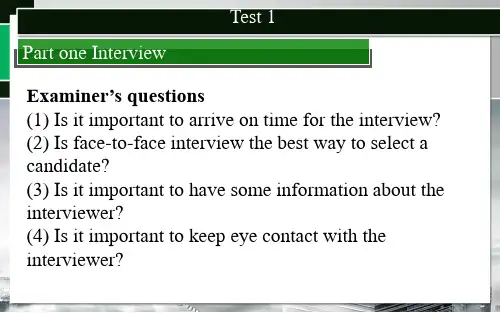
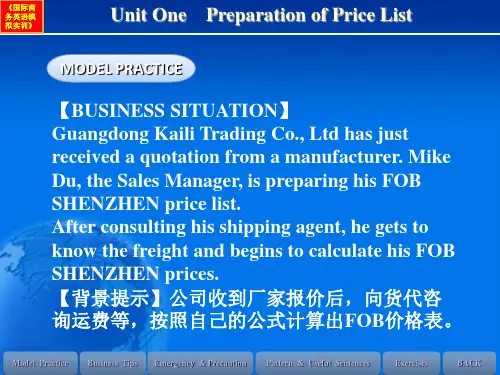
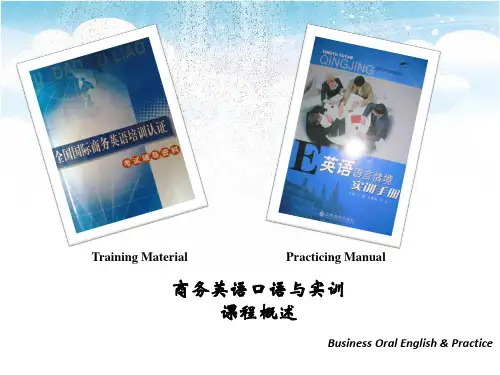
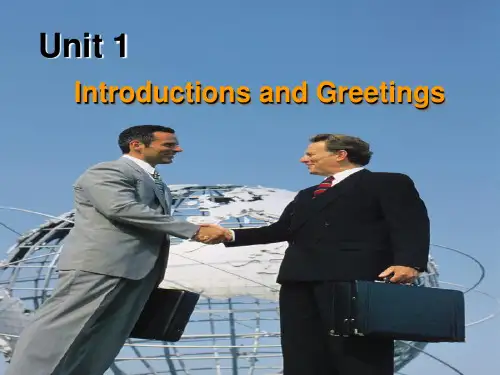
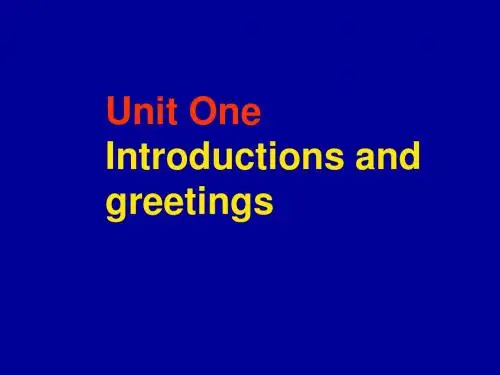
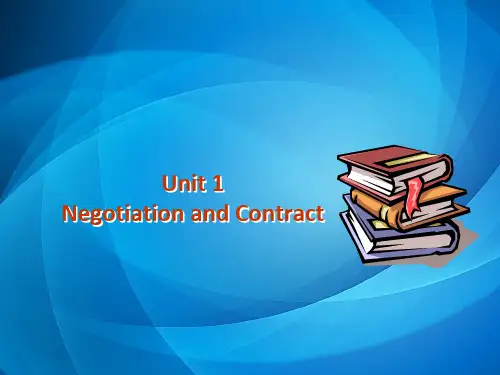

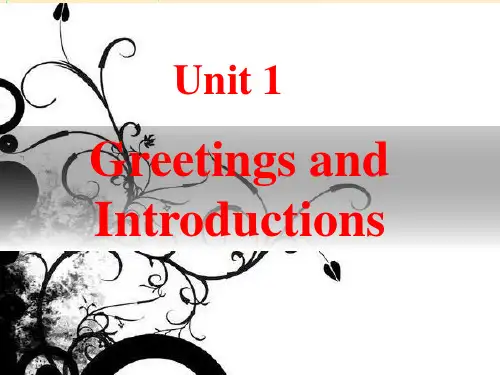
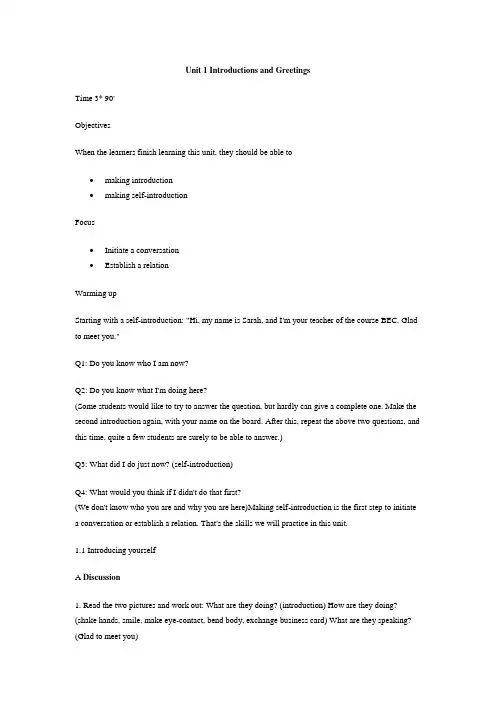
Unit 1 Introductions and GreetingsTime 3* 90'ObjectivesWhen the learners finish learning this unit, they should be able to∙making introduction∙making self-introductionFocus∙Initiate a conversation∙Establish a relationWarming upStarting with a self-introduction: "Hi, my name is Sarah, and I'm your teacher of the course BEC. Glad to meet you."Q1: Do you know who I am now?Q2: Do you know what I'm doing here?(Some students would like to try to answer the question, but hardly can give a complete one. Make the second introduction again, with your name on the board. After this, repeat the above two questions, and this time, quite a few students are surely to be able to answer.)Q3: What did I do just now? (self-introduction)Q4: What would you think if I didn't do that first?(We don't know who you are and why you are here)Making self-introduction is the first step to initiate a conversation or establish a relation. That's the skills we will practice in this unit.1.1 Introducing yourselfA Discussion1. Read the two pictures and work out: What are they doing? (introduction) How are they doing? (shake hands, smile, make eye-contact, bend body, exchange business card) What are they speaking? (Glad to meet you)2. Unlike in Chinese, self introduction in English is conducted in this way (on board):1) greeting (Hi)------presenting one's name (My name is/ I am XXX )------showing willingness for the meeting(nice to met you).2) respond with showing happiness(nice to met you, too)------- present one's name (My name is/ I am XXX ).B Listening & Demonstration.1. Listen to the tape and match the conversation to the pictures.Imitation is necessary as that can help student familiarize with verbal devices, and then facilitate later demonstration.2. DiscussionQ1: Is there any difference between the two dialogue? (Yes.)Q2: What is it? (The first is more formal than the second one.)3. Role play1) Practice with partner as at a business meeting where you are strangers to each other.2) Help is offered when needed but encouragement is more needed as students are not used to this practice, while some think this is too easy.4. Demonstration1) Ask students come to the stage to demonstrate. The first group should be the one who have not practiced seriously. By demonstration, they can realize that practice doesn't mean reading is enough.2) The later group should be volunteers.5. Discussion on demonstration with such questions:1) Is there any room for improving ?2) What suggestion would you make?6.Sum up the discussion:Not only verbal devices should be employed, non-verbal devices also are required in self introduction, such as hand shake, smile, bend body, offer business card, and etc.7. Demonstration again. Encourage those who have practiced do that again first, then others.C ListeningThe listening material is not tough at all but is can be designed as the base for later practice.1. Listen to the recording.2. After listening, all students are to give oneself a new name and put it on a slip. Collect the slip and then ask some one to take one of them and then start looking for the one bearing the name on the slip.3. Useful expression:Excuse me. Are you XXX?Sorry for interruption.That's alright.1.2 Saying where you are fromA Reading1. Read this advertisement and make the statements True or False.2. Check the answer.This reading material is not tough literally speaking. However for students, the name of certain cities or countries are of problem as they are seldom mentioned in their other textbooks. After finishing 1.2, the students should get an idea that as an international business person, one has to know the main business countries as well as their cultures, so they would try to collect such related information on their own.Suggested answer: 1) T, 2) T, 3) F, 4) T, 5) F, 6) T, 7) T, 8) F, 9) TB Listening1. Make sure of the requirement for this task -- Match the guests' names to the office.1) Read the name of the cities properly.2) Know ell the cities are located repectively.2. Listen to the tape twice.Suggested answer: 1) Moscow , 2) New York , 3) Colombia , 4) New Delhi ,5) New Delhi , 6) Beijing , 7) BrusselsC Role play1. Read the file on Page 116 and 118 respectively and make sure that the aim of the task is clear and well understood.2. Practice in pairs while teacher should tour round in the classroom and offer help in case it is needed. Encouragement is motivation.3. Demonstration and comment.1.3 Introducing other peopleA ListeningThis task is also easy in terms of literally devices, but doing that as role play could help students to see how badly skill practice they need.plete the conversation with the phrases in the box.1) Complete the conversation.2) Check the answer.Suggested answer: 1) How are you? 2) do you know Brian Turner? 3) He works in Milan .4) Please to meet you, Mr. Tokini. 5) Have a seat, Giovanni. 6) Cream and sugar, please.2. Role play based on the completed conversation.3. Discuss: Making introduction is a common practice in business career. How to do that? There are some tips:∙Introduce the visited one to the visiting one first.∙Introduce the junior positioned one to the senior one first.∙Introduce the younger one to the elder one first.∙Introduce the male to the female first.∙After conducting introduction, the introducer usually should find an excuse as to leave the new acquaintances to chat.B Language focus1.Study the examples in the box.2. Read the files on Page 63, Yuki's file, File 29 and 30, discuss which of the four would be favorable as candidates?C WritingLook at the pictures and work out what people are saying.This task is based on previous practice and it is always very easy for students majored in English.It can be taken as a relax as previous practice and discussion is some stressful.Sum-upIn this unit, we learnt:1. How to properly make a self introduction as to establish a relation.2. How to properly make others known to each other by an introduction.3. In communication, non-verbal devices are required.Assignment1. Role pay: group leader should see that every one in the group practices the skills of introduction and self introduction. ( A demonstration is to be made in next session).2. Learn all the names of countries and cities by heart.。
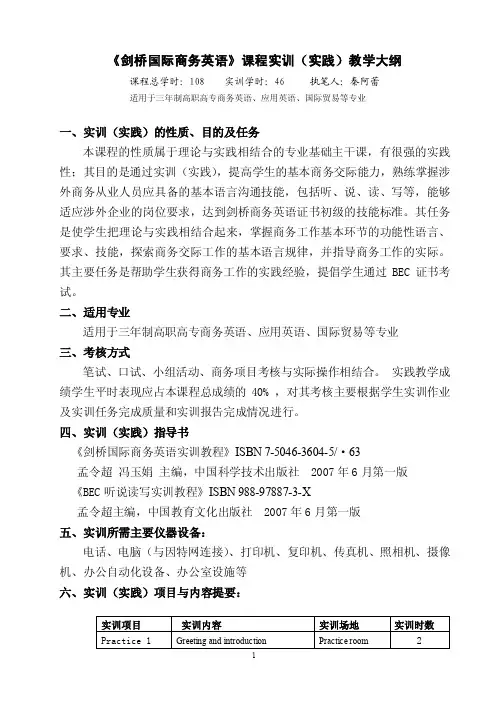
《剑桥国际商务英语》课程实训(实践)教学大纲课程总学时:108 实训学时:46 执笔人:秦阿蕾适用于三年制高职高专商务英语、应用英语、国际贸易等专业一、实训(实践)的性质、目的及任务本课程的性质属于理论与实践相结合的专业基础主干课,有很强的实践性;其目的是通过实训(实践),提高学生的基本商务交际能力,熟练掌握涉外商务从业人员应具备的基本语言沟通技能,包括听、说、读、写等,能够适应涉外企业的岗位要求,达到剑桥商务英语证书初级的技能标准。
其任务是使学生把理论与实践相结合起来,掌握商务工作基本环节的功能性语言、要求、技能,探索商务交际工作的基本语言规律,并指导商务工作的实际。
其主要任务是帮助学生获得商务工作的实践经验,提倡学生通过BEC证书考试。
二、适用专业适用于三年制高职高专商务英语、应用英语、国际贸易等专业三、考核方式笔试、口试、小组活动、商务项目考核与实际操作相结合。
实践教学成绩学生平时表现应占本课程总成绩的40% ,对其考核主要根据学生实训作业及实训任务完成质量和实训报告完成情况进行。
四、实训(实践)指导书《剑桥国际商务英语实训教程》ISBN 7-5046-3604-5/·63孟令超冯玉娟主编,中国科学技术出版社 2007年6月第一版《BEC听说读写实训教程》ISBN 988-97887-3-X孟令超主编,中国教育文化出版社 2007年6月第一版五、实训所需主要仪器设备:电话、电脑(与因特网连接)、打印机、复印机、传真机、照相机、摄像机、办公自动化设备、办公室设施等六、实训(实践)项目与内容提要:七、实训项目具体说明:Practice 1 Greeting and introduction实训目的与要求:Practice greeting and introducing business professionally预备知识:Cultural background knowledge; functional sentences used to greet people and to make introduction in different situatuions实训内容:greeting people and introduce formally and informally实训步骤:language preparation; personal practice; pair work; making new friends; performancePractice 2 Telephoning实训目的与要求:Practice telephoning businesslike预备知识:Functional telephoning language; telephoning skills; telephonemessage实训内容:telephone coversations; telephone free talks; telephoning ang note-taking实训步骤:Language preparation; personal practice; pair work; role-play; performancePractice 3 Internal communication实训目的与要求:Practice internal comunication methods, mainly written form 预备知识:internal communication methods; different language styles实训内容:emails;memos; reports; notice and so on实训步骤:Personal reading business task and selecting the best way to communicate and draft the materialsPractice 4 Facts, figures and performance实训目的与要求:practice reading ,understanding and analyzing charts,pictures and other visal materials about Facts, figures and performance effectively and correctly预备知识:skills to read pictures ,tables and other ways of showing facts, figures and performance;functional sentences used to describe various ways of showing facts, figures and performance; functional sentences used to describe them.实训内容:oral and written presentation of visual materials showing facts, figures and performance;business examples reading and writing实训步骤:personal;group work; classroom presentation; paper work.Practice 5 Reading skills实训目的与要求:Practice reading business materials efficiently and correctly预备知识:skills for reading实训内容:materials from real business cases实训步骤:reading ,checking and group markingPractice 6 Business equipment实训目的与要求:Practice using often-used business equipment correctly and safely预备知识:Functional language used to instruct to use equipment实训内容:Correct operation of telephones,mobile phones,fax machones,computers,printers,copiers and so on.实训步骤:teachers’ demonstration; menmbers in the group practice one by one; operate all the equipmentPractice 7 Correspondence实训目的与要求:Practice reading and writing business correspondence预备知识:the layout ,style and functional language for different business correspondence实训内容:simutinous business correspondence reading and writing实训步骤:reading task directions, finish the task within limitted time;group correction, teachers markingPractice 8 Writing skills实训目的与要求:practice writing business materials efficiently by using the revelant given materials预备知识:How to read writing directions and requirements,How to organize sentences实训内容:The skills to write eamil, memo and other often-used business materials within a time limit.实训步骤:Teachers’ assignment; Individual writing; group discussion; Self correction, teachers’assessment.Practice 9 Booking a hotel room实训目的与要求:Practice booking a hotel room by telephone professionallly.预备知识:background knowledge about hotel booking and Functional language for it.实训内容:booking a hotel room as a customer and dealing with a hotelroom reservation as a receptionist in a hotel. V arious kinds of booking.实训步骤:teachers’presentation of business situation;Students’p air work; group work; classroom role-play demonstration.Practice 10 Asking and giving directions实训目的与要求:Practice asking and giving directions correctly预备知识:functional lnguage used to ask and give directions in different situations实训内容:asking a local person the way to a certain place; giving directions to others实训步骤:get familiar with the language used in the practice; pair work; classroom demonstration.Practice 11 Arranging a conference实训目的与要求:Practice arranging a conference professionally预备知识:knowledge and skills about conference arrangment; functionallanguage;Procedure in arranging conference; conference programme style and layout.实训内容:decide the topic/budget/location/who will present/accommodation/traffic/programme details;Invitation of delegators; decide the lecturers.实训步骤:Practice the main procedure in arrangine a certain conference; role play; draft a programme.Practice 12 Listening skills实训目的与要求:practice listening efficiently and correctly;get required information by listening预备知识:knowledge and skills for different kinds of listening实训内容:various listening materials selected from business context;实训步骤:Understanding of short coversations; note taking, longer passage listening.Practice 13 Speaking skills实训目的与要求:Practice speaking skills and achieve effective communication with others, especially in business situation.预备知识:knowiadge ang skills in business speaking; body language; cultural background.实训内容:Personal identification,expressing preferences about general topics; presentation anout a business topic;making a business decision by collaborative work.实训步骤:teachers’ assignment;pair work;role play; classroom demonstrationPractice 14 Trading实训目的与要求:Practice several key steps in internation trade预备知识:knowledge and functional language used for business enquiry, quotation, offer, counter offer,order, confirmation of receiving the order , price terms in negotiation实训内容:enquiry, quotation,order, confirmation of receiving the order实训步骤:teachers’ descript ion of a business situation; students complete the main steps of the business.Practice 15 Recruiting staff and applying for a job实训目的与要求:practice recruiting staff profesionally and applying for a job businesslike预备知识:knowledge;skills and functional sentences used to recruite staff and apply for a job实训内容:recruiting staff ; applying for a job实训步骤:teachers’ assignment; recruiting as an HR officer and apply for a job as a job hunter. pair work;group work; classroom demonstration.Practice 16 Comprehensive practice实训目的与要求:Practice the comoprehensive ablity in dealing eneryday business avtivities.预备知识:the mail background konwledge, skills, functional sentences uesd to deal with company business as a secretary or assistant.实训内容:according to a business event,deal with or help managers deal with the everyday work as a secretary.实训步骤:Teachers’ requirement; Students’ invention of a business story according to the business event described by the teacher; role play; group work. Teachers’ asse ssment.八、大纲审核人员会签教研室主任(签名):孟令超系教学副主任(签名):张彦鸽系主任(签名):陈思顺教务处审批(签名):。
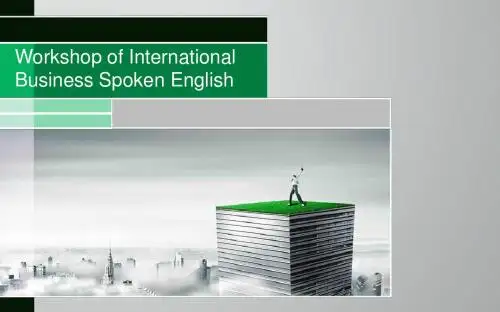
Unit 1 Introductions and greetings介绍和问候本课重点:自我介绍和介绍日常问候学习意义:1 由于不同的文化,汉语的自我介绍方式与日常问候都和英语的不同。
作为国际商务人士,能娴熟运用英语作自我介绍及进行寒暄不但令当事人有自信,也有益于拓展商务合作关系或自我发展。
2 尽管同学们曾在一开始学习英语时就学习了如何介绍自己和别人以及日常问候的句型,似乎在语言点上无需再重复。
但实际上由于生活环境、经历和本土文化影响,我们的同学很少在实际生活中运用英语介绍自己和他人的技巧。
即使做类似联系也多是面对同学,只求语言流畅,语音正确。
但在商务英语课程中,介绍和问候被看作一种综合技能来训练,要求学生不仅能流畅准确地说出,还要求学生能正确的表达——即正确运用在从事这些活动时情景必需的身体语言和表情,能具备国际商务交往中基本的交际能力。
3 熟悉一些主要的商业国家和城市。
学习建议:1.注意观察教师的示范,并按要求与同座进行练习。
在练习时应尽可能与对方保持一米左右距离,这样才能提醒自己声音清晰,否则对方无法听清。
提醒自己进入角色,在进行介绍和问候时要与对方保持目光接触、面带微笑,握手时身体略前倾。
如没把握,可观摩同学的练习或请求教师予以指导。
2.和对方各自为自己起一英语名并不让对方知道,将英语名写于纸上后再与对方一起练习自我介绍和问候。
然后各自将听得对方的姓名写下交对方检验是否正确。
这个练习的目的是促使学习者能下意识要求自己能语音清晰、举止大方的与人交谈,还能有礼貌的倾听对方,有效获取信息。
3.主动要求在班上示范,这样能帮助掌握社交基本技巧,也能逐步获得自信,为今后的课堂活动和商务实践打下较好的基础。
外贸英语口语精品课程Title: Mastering International Trade English ConversationsI. IntroductionWelcome to our exceptional course on mastering foreign trade English conversations! In this course, we will provide you with essential conversational skills and phrases to confidently navigate the world of international trade. Whether you are an importer, exporter, or trade professional, this course will equip you with the necessary tools to communicate effectively and succeed in the global marketplace. II. Key Vocabulary and Phrases1. Introduction and Greetings:- How do you do? / Nice to meet you.- My name is [Name].- I'm from [Country].- What brings you here today?2. Establishing Business Connections:- I represent [Company].- We specialize in [Product/Service].- I'm interested in discussing potential business opportunities.3. Negotiations and Deals:- What are your terms and conditions?- Can we negotiate the price?- Is there room for a bulk order discount?- Can we arrange a sample for evaluation purposes?- When can we expect the delivery?4. Product Inquiries and Specifications:- Could you provide me with more details about the product?- What are the available sizes, colors, and materials?- Does it come with any warranty or guarantee?- Do you have any certifications for the product?5. Shipping and Logistics:- How do you usually ship goods?- What are the shipping costs and delivery timeframes?- Can you recommend any reliable freight forwarders?- Are there any import/export regulations we should be aware of?III. Practical Scenarios and Dialogues1. Scenario: Introducing Your Company- A: How do you do? I'm [Name] from [Company].- B: Nice to meet you, [Name]. I'm [Name] from [Company].- A: Thank you. It's a pleasure to meet you. What brings you here today?- B: We are looking to expand our supplier network and source high-quality products.2. Scenario: Negotiating Prices and Terms- A: We are interested in your products. What are your terms and conditions?- B: Our prices are competitive, and we offer flexible payment options.- A: Can we negotiate the price for a bulk order?- B: Yes, we can consider a discount for bulk orders. Let's discuss the quantities and terms further.3. Scenario: Inquiring about Product Details- A: Could you provide me with more details about the product?- B: Certainly! What specific information do you need?- A: I'm interested in sizes, colors, and materials available.- B: Our product comes in various sizes, colors, and materials. Let's discuss your requirements in detail.4. Scenario: Arranging Shipping and Logistics- A: How do you usually ship goods?- B: We work with reliable freight companies for both air and sea shipments.- A: What are the shipping costs and delivery timeframes to [Destination]?- B: We can provide you with a detailed quotation and estimated delivery timings for your destination.IV. Final Tips and Wrap-UpThrough this course, you have gained a strong foundation in essential foreign trade English conversations. Remember to practice these phrases regularly to reinforce your proficiency. Additionally, staying up-to-date with industry news and ongoing international trade developments will further enhance your communication skills.With these newfound conversational skills, you are now better prepared to engage in business negotiations, inquiries, and logistics discussions with confidence. Wishing you success in all your international trade endeavors!Remember, practice makes perfect!。
Richard and his old classmateThere is a knock at the door. Mrs. White goes to open the door and sees a young man standing there with a colorful box in his lift hand.Hugh: Good afternoon. You must be Mrs. White.您肯定是怀特太太。
Mrs. White: Yes. And you are…Hugh: My name is Hugh Fox.我叫Hugh Fox。
I’m here to visit Richard. Is he in?Mrs. White: Yes, he is. Come in, please. Richard, your friend is here.Richard: Hi, Hugh.Hugh: Hi, Richard.Richard: I don’t thin k you’ve met my dad, Hugh. Hugh,我想你还没有见过我爸爸。
This is my dad. And Dad, this is my friend Hugh.这是我爸爸。
爸爸,这是我的朋友Hugh。
Hugh: How do you do, Mr. White? I’m glad to meet you.您好,怀特先生。
很高兴见到您。
Mr. White: Hello. I’m glad to meet you, too.你好。
也很高兴见到你。
Richard: And I think you’ve met my mom, haven’t you?Hugh: Yes. Nice to meet you, Mrs. White.很高兴见到您,怀特太太。
Mrs. White: Pleased to meet you, Hugh.很高兴见到你,Hugh。